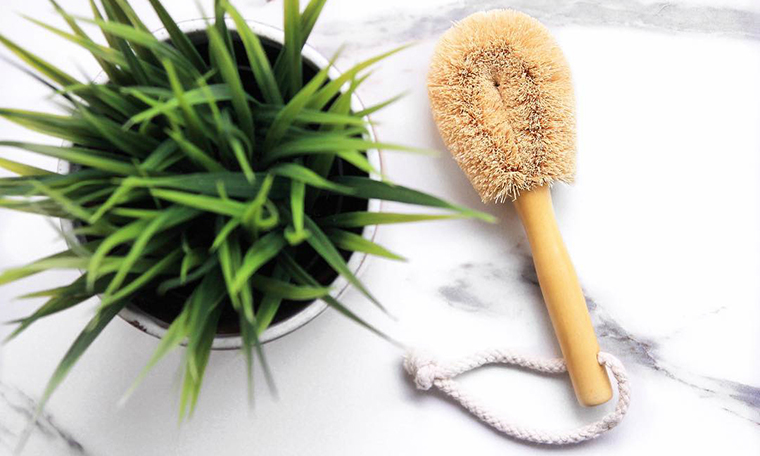We spoke to two licensed aestheticians who’ve done their fair share of dry brushing. With their expertise, we’re answering all your questions about dry brushing basics, execution, tricks, and safety tips.
If you’ve spent any time perusing beauty or skincare blogs in the last few years, chances are you’ve probably heard the phrase “dry brushing.” It’s a pretty strange-sounding term, though, and that may have caused you to write it off as just another temporary skincare trend. Here’s the thing, though, kids. Dry brushing is actually pretty straightforward, and it’s here to stay.
What Exactly Is Dry Brushing?
In short, dry brushing is exfoliation. Only instead of using water and a product to buff away dead skin cells, you use a dense, bristled brush (or similar) directly on top of dry skin. In addition to exfoliating the top layer of skin, dry brushing also helps stimulate lymphatic drainage and increases blood circulation.
“The lymphatic system is essentially like a filtration system with no pump,” explains Ashli Carnicelli, a massage therapist and licensed aesthetician. “It relies on musculoskeletal movements, as well as mechanical manipulation to move the lymph through the body.”
In that sense, dry brushing rids both external and internal gunk from your body. Sounds kind of weird, we know.
“Think about it. If the surface of the skin has clogged pores, then your body can’t release the internal toxins that need to be expelled and build up, thus affecting your skin’s appearance and your health,” says licensed aesthetician Heather Harzold.
In addition to all the above, dry brushing also makes your skin look and feel incredibly soft. Plus, because it creates a cleansed, smooth canvas, it also allows your skin to better absorb products, and can even make skin look tighter and firmer.
What Tools Do I Need?
You probably could guess this one yourself, but the only thing you need for a dry brushing session is, well, a dry brush! Contrary to what you may assume, though, dry brushes come in many forms, and you don’t have to restrict yourself to brushes that are marketed as such.
For example, there are dry brushes that you can easily hold in the palm of your hand, and dry brushes that have long handles that make it easier to reach difficult locations (such as your back). Bristled shower brushes are perfect for this. Exfoliation gloves and dense loofah or sea sponges also work. Just make sure your skin and the tool are both dry.
How Do You Dry Brush?
On dry skin, start brushing in a circular motion at your ankles. Slowly make your way up your legs and then in and around your thighs and butt, advises Carnicelli. She says you should really focus on the outer thighs, and any other area that may feel sluggish.
Next, start at your fingertips and brush up your arm toward your heart. Make sure you keep brushing in a circular pattern. For your stomach, you’ll want to change things up a bit. Instead of a circular motion, brush downward toward your navel.
Note that dry brushing may feel uncomfortable the first couple of times you do it, but your body will adapt if you’re consistent.
How Often Should You Dry Brush?
Every day, girl. Every day.
When’s the Best Time to Dry Brush?
“The morning is the best time for dry brushing because it does invigorate and stimulate your system,” says Harzold. “It can be done at night, but not too late, and most effectively before a shower and not after.”
Does It Really Get Rid of Cellulite?
We hate to be heartbreakers, but your mileage will vary when it comes to cellulite elimination via dry brushing. Some say it really affects the appearance while others say they can’t tell a difference. Consider it a bonus side effect if you land in the former camp.
Can You Dry Brush Your Face?
We advise against dry brushing your face because the bristles tend to be too abrasive for the delicate, sensitive skin there. You’re better off sticking to your regular facial exfoliator.
Any Safety Precautions To Be Aware Of?
While dry brushing, make sure you avoid abrasions, rashes, and sensitive areas, such as your face (as mentioned), breasts and private parts. Additionally, Carnicelli says that if you’ve ever had lymph nodes removed due to cancer (such as the axillary lymph nodes in the armpits that are often removed due to breast cancer), or if you’re dealing with any sort of lymphoma or unexplained swelling, you should forego any and all dry brushing.














